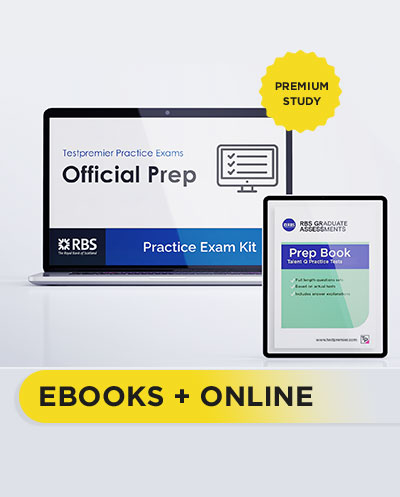
RBS Online Practice Test
Securing a position at the Royal Bank of Scotland (RBS) is a dream for many aspiring professionals in the finance and banking industry. To make this dream a reality, candidates must pass the RBS Practice Aptitude Test, a critical step in the recruitment process. In 2024, RBS continues to set high standards for its applicants, and being well-prepared is essential. This blog post will guide you through the RBS Practice Aptitude Test Pack [Year], helping you maximize your chances of success.
1. Understanding the RBS Practice Aptitude Test
Before delving into the test pack itself, it’s crucial to understand what the RBS Practice Aptitude Test evaluates. This test assesses your numerical, verbal, and logical reasoning skills, as well as your situational judgment. Familiarizing yourself with the test’s format and the types of questions you can expect is the first step toward success.
2. What’s Inside the RBS Practice Test?
The RBS Practice Aptitude Test Pack for 2024 is a comprehensive resource designed to help you prepare effectively. It typically includes:
- Numerical Reasoning Practice Tests: These assess your ability to work with numbers, interpret data, and solve mathematical problems under time pressure.
- Verbal Reasoning Practice Tests: These evaluate your reading comprehension and language skills by presenting passages followed by questions.
- Logical Reasoning Practice Tests: These measure your ability to analyze patterns, make deductions, and think critically.
- Situational Judgment Tests: These assess your judgment and decision-making skills in realistic workplace scenarios.
- Detailed Explanations: Each test question is accompanied by detailed explanations, helping you understand the correct answers and improve your skills.
3. How to Use the RBS Practice Aptitude Test Pack
To make the most of this resource, follow these steps:
- Assessment: Start with a self-assessment to identify your strengths and weaknesses in each area (numerical, verbal, logical reasoning, situational judgment).
- Regular Practice: Allocate dedicated study time to practice regularly. Work on improving your weaknesses while maintaining your strengths.
- Time Management: Practice answering questions under time constraints to simulate test conditions accurately.
- Review and Learn: After completing each test, review your answers and the provided explanations. Learn from your mistakes to avoid repeating them.
4. Additional Tips for Success
- Stay Updated: Ensure you are using the most up-to-date version of the RBS Practice Aptitude Test Pack, as test formats may evolve over time.
- Simulate Test Day: Mimic the test day experience as closely as possible during your practice sessions. This includes the environment, time limits, and even your mental state.
- Seek Guidance: Don’t hesitate to seek advice from mentors, career counselors, or peers who have successfully passed the RBS Aptitude Test.
RBS Aptitude tests formats; What to expect:
RBS mostly uses Talent Q style tests for its candidate selection. The sections on the assessments may include any of the following test sections, depending on the role that you applied to and also the country you are applying from:
- Numerical Reasoning
- Verbal Reasoning
- Logical Reasoning
- Situational Judgement Test
- Group Exercise
- Presentation
- Interview
- Personality Test
Sample Questions for RBS Practice Tests and Worked solutions
RBS Graduate Practice Pack Numerical Reasoning
Question 1 What proportion of the medals won by France are Silver?
A. 20%
B. 30%
C. 40%
D. 50%
E. 60%
EXPLANATION The total medals won by France are: Gold = 7, Silver = 16, Bronze = 17. Total = 40, therefore the proportion of Silver won by France Is 16/40 x 100 = 40%.
Answer: (C)
Question-2 What was the percentage difference in the total silver medals won between Australia and bronze medal won by Italy?
A. 33%
B. 30%
C. 25%
D. 39%
E. 60%
EXPLANATION Percentage difference of total silver won by Australia and bronze won by Italy? Bronze by Italy = 10, Silver by Australia = 15, Therefore = (15 – 10)/15 x 100- = 33%.
Answer: (A)
Question-3 What proportion of the medals won by Germany is gold?
A. 35%
B. 38%
C. 27%
D. 39%
E. 30%
EXPLANATION The proportion of medical that is gold won by Germany is Total medal won by Germany = 16 15 10 = 41 medals = 16/41 x 100 = 39.02% ≈ 39%.
Answer: (D)
RBS Graduate Practice Pack Verbal Reasoning
People assume that they go to the hospital to get well. However, in the past few years, this perception has been challenged by the real risk of acquiring a deadly infection while in hospital. As a consequence, public confidence in the health service has suffered. An antibiotic-resistant the strain of bacteria was first identified in the 1950s. It was a staphylococcus common in abscesses and bloodstream infections and it had become resistant to the antibiotic penicillin. Since then the bacteria have become resistant to a second antibiotic and have become established as a source of infection in many nursing homes and hospitals. Today it is believed to cause about 1,000 deaths each year as a result of hospital-acquired infections. Action that can beat this ‘superbug’ is simple but expensive. It requires very high levels of hygiene and cleanliness and a programme of testing so that infected patients can be isolated and treated.
Question 1. Staphylococcus infections kill around 1,000 people a year.
A. True
B. False
C. Cannot tell
Question 2. If clean hospitals had been a priority in the 1950s we would not face this threat today.
A. True
B. False Answer
C. Cannot tell
Question 3. Staphylococcus became established as a source of infection in many nursing homes and hospitals in the 1950s.
A. True
B. False
C. Cannot tell
Question 4. Staphylococcus has become a ‘superbug’.
A. True
B. False
C. Cannot tell
Question 5. Infections of the bloodstream are more serious than abscesses.
A. True
B. False
C. Cannot tell
Answers
Question 1. B, Explanation: The 1,000 deaths result from hospital-acquired infections;
Question 2. C, Explanation: The passage provides no information on how the antibiotic-resistant bacteria might have been countered in the 1950s;
Question 3. B, Explanation: The passage states that the infection became established in hospitals and nursing homes since that time;
Question 4. A, Explanation: The term is used to describe it in the passage;
Question 5. C, Explanation: The passage does not provide information on the relative severity of these conditions.

